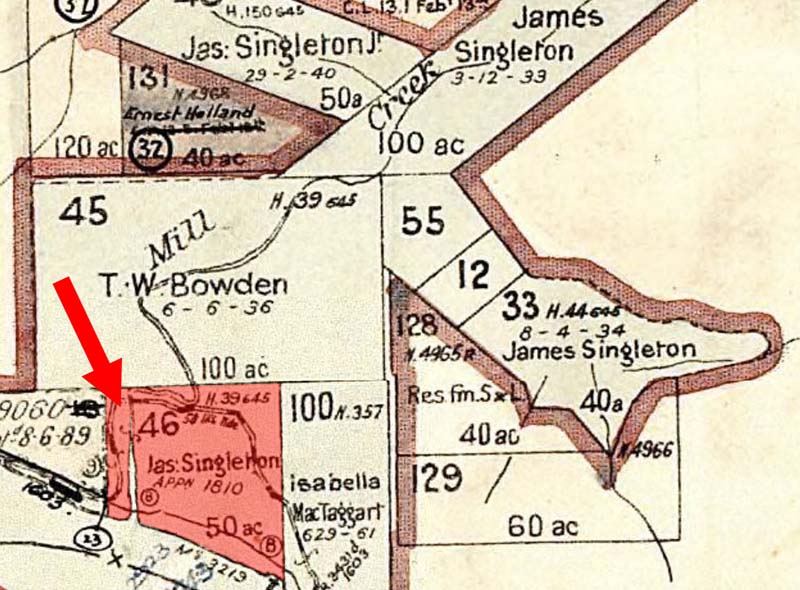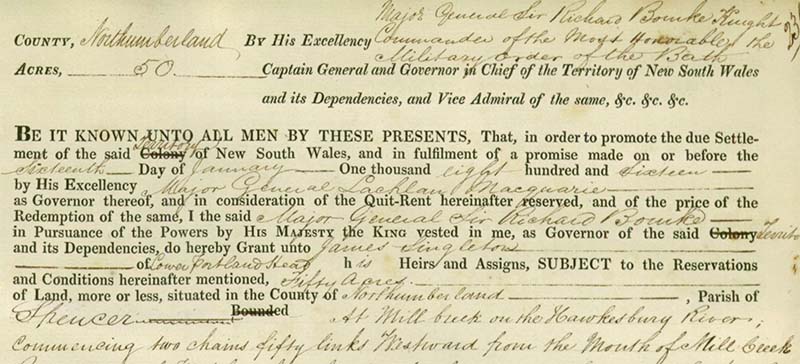
The Dillons Creek Tidal Watermill
aka Myrtle Creek, Green's Mill, Milton, Singleton's Mill
Singleton Mills homepage > The Wisemans Ferry Mills > The Dillons Creek Mill
The second tidal flour mill that James Singleton established in the Wisemans Ferry area was built on Portion 46 in the parish of Spencer.
This mill was built about 350m from the mouth of a creek, which was called at various times, Mill Creek, Dillons Creek and Myrtle Creek, on the northern side of the Hawkesbury River.

Above: an old Parish Map showing Portion 46 (coloured red) which was granted to James Singleton and where he built his mill. James also owned three other portions upstream from his mill. The site of the mill and millhouse is shown with the red arrow. Note: this area is located on a private road.
Ruins on the site
Some stone foundations of the mill have been recorded in the creek.
Substantial remains of the stone cellar of the millhouse are also still standing.
Above: the heritage-listed stonework that remains of the cellar area of James Singleton's millhouse at Dillons Creek. Photographed by Les Dollin in 2007.
The decaying remains of a bridge that was built over Dillons Creek near the mill site were still visible in 2007.
Above: the remains in 2007, of the old bridge that was used by James Singleton to cross Dillons Creek. Photograph by Les Dollin.
Descriptions of mill
The first description of this mill that we have found was in the journal of Mrs Sarah Felton Mathew on 20 May 1833. Mrs Felton Mathew was the wife of the then Assistant Surveyor who was assigned to survey land in this area. She made intrepid journeys with her husband as he did his work and she described them in a fascinating journal. They travelled in sailing ships up the rivers and camped in rough tents in very remote areas.
On the morning before Mrs Felton Mathew visited this mill site, she had been alarmed by the approach of 'suspicious characters' that she feared were bushrangers. She wrote:
"… I could not but be terrified considering that there was no protection near, and the desperate conduct of some of these wretches : I proceeded however as coolly as possible to hide a few things, to get out a large pistol which I knew was loaded and conned over the way to cock and fire it. I also let loose a dog belonging to one of the men, which had been tied up near the tent : but the coward seeing my fear only sneaked under the table, trembling as much as I did ;
… mean time the noises became louder, and approached nearer, while I stood grasping the tent pole, with the pistol on the table ready to my hand but out of sight … among the fragments of rock, the two strangers were clambering. I rejoiced to see they were unarmed and seemed afraid of venturing down the path, as well they might since Philips, with 2 guns which he assured them were loaded declared he would fire if they approached the tent ; they made some excuse that they were searching for a strayed animal and said they were servants of Mr. Green of the Mill … "
On the following day, 20 May 1833, they moved their camp, sailing up "Mill Creek" (Dillons Creek) and camping just below the Miller's house. They learned that the two men they encountered on the previous day were indeed servants of "Green the Miller".
Mrs Felton Mathew described the mill as follows:
"There was something rather English in the appearance of this water mill, and the scenery around was bold and romantic : the mountains on one side rise so precipitously that there is just level ground enough for the Miller's house and buildings, and the creek takes a very sudden turn close beyond the mill, so that it seems quite shut in on all sides : the only access to it is by water and the number of little boats plying up and down all day, formed a lively scene, somewhat novel in this secluded spot."
Source: Mrs Felton Mathew’s Journal, by Olive Harvard (1943), JRAHS, Vol. 29 (2), pages 109-111.
Further good descriptions of the mill have been found in advertisements in newspapers of the time:
The Australasian Chronicle, 31 August 1841, described the property as follows: 50 acres, half with rich alluvial cleared land in cultivation and a well-fenced orchard. A blacksmiths shop, piggery and two paddocks.
The Mill is weatherboard on a stone foundation. It has two pairs of French Burr stones, each 4' diameter. One pair is at work grinding six to eight bushels per hour [220-290 litres].
The Millhouse is built from cut stone on a solid stone foundation. Three front rooms, two back rooms, three sleeping places for servants upstairs, a spacious loft in the roof. A cellar underneath which opens to the wharf.
The Sydney Morning Herald, 21 February 1854, stated: "The Farm called "Milton" situate on Myrtle Creek and the Hawkesbury, consisting of 50 acres, mostly under cultivation, together with the tidal Flour Mill at present in the occupation of Mr. Charles Douglass. There is a substantial stone-built two-story Dwelling House upon this property, close to the mill, which is well known as one of the best employed on the river, and might, under enterprising management and a moderate expenditure, be made capable of doing much more than double its present work."
and
The Sydney Morning Herald, 11 November 1859, stated: "To be sold or let, Flour Mill and Farm of about 50 acres, on Myrtle Creek, Lower Hawkesbury, as now occupied by George Greentree. There is a good stone-built dwelling-house on the property, and the mill is driven by water, and well employed in good seasons."
History of the mill
On 16 January 1816, Thomas Dillon was promised the 50 acres of land, where this mill was later built. He built a house there and a footbridge over Dillons Creek.
However, he came into significant conflict with local Aboriginal people, and in about 1820 he fled with his wife and five young children to the Appin district near Camden.
After his departure, John Finley, a servant of Thomas Dillon, continued to live in Dillon's house on this property. In 1822, some escaped convicts came to the property and were assisted by John Finley. The lively story of this event is told in detail in the book "Early Wisemans Ferry" by John amd Pam Ball.
The date when James Singleton established his mill on this property is not known. However, it appears to be sometime between the Finley's encounter with the convicts in 1822 and Mrs Felton Mathew's visit to the operational mill in May 1833. The position of the mill is also shown on the crown plan drawn by Assistant Surveyor Felton Mathew in 1833.
On 14 May 1834 James Singleton made a formal claim for the land promised to Thomas Dillon, then on 6 June 1835, James Singleton was granted this 50 acres of land.

Above: the formal grant to James Singleton of the 50 acres of land at Dillons Creek where he established his mill.
Thomas Green, the step-son of James Singleton, was the Miller when Mrs Felton Mathew made her visit in 1833. The mill became locally known as Green's Mill at this time.
James Singleton Junior (1814-1890) was recorded as living at Myrtle Creek in the 1841 Census of New South Wales. He was the son of James Singleton (ca. 1776-1849) who established the mill.
Other people recorded as occupiers of this property were:
-- Mr T. Sawkins in 1846,
-- Charles Douglass in 1854,
-- George Greentree in 1859, and
-- Thomas Greentree in 1867.
"The next case calling for relief was that of a man named Thomas Greentree, a miller, whose house and mill were inundated by the flood, furniture washed out and destroyed and rendered valueless.
The man ran up a rude gunyah on the side of the hill, and thither he removed his family from reach of danger, together with such articles as were rescued from the mighty rushing river. This man, who had twelve in family, … stated that he did not require anything. Subsequent inquiries elicited the fact, however, that he had only sufficient corn to last his family either five or six days, and that he had no money to purchase more…"
The damage that the Dillons Creek mill sustained in the 1867 flood may have brought its productive period to an end. In 1878, the property was purchased by Walter Bailey and it is thought that machinery and materials from Singleton's Mill at Dillons Creek were used in the later construction of the Bailey sawmill at the mouth of the Dillons Creek.
Further Reading
• The Wisemans Ferry Mills • Nagles Creek Mill • Laybury Creek Mill